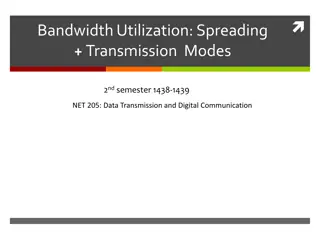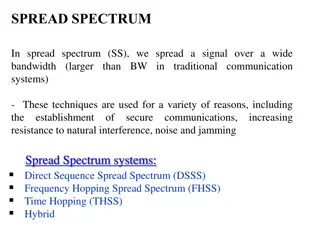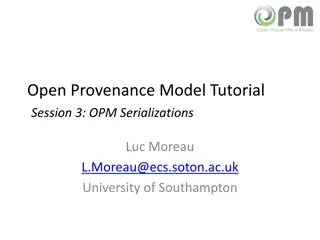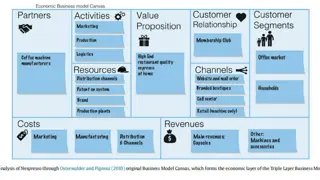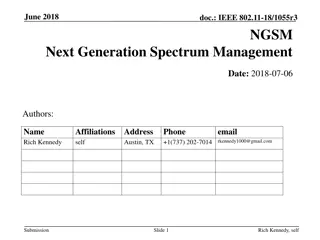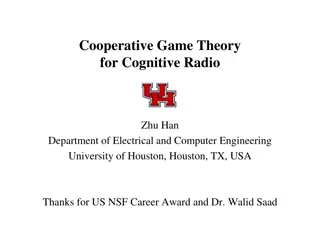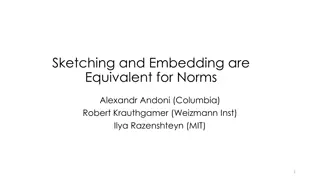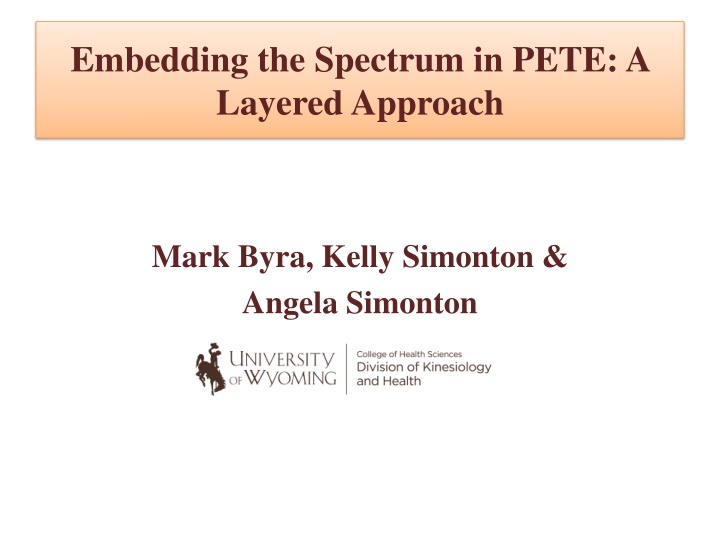
Spectrum-in-PETE: Layered Approach to Physical Education Teacher Education
Explore the Spectrum-in-PETE approach with a layered methodology involving various activities and courses over the 4-year Physical Education Teacher Education program. Dive into movement cores, learning activities, and teaching labs aimed at developing teaching skills and practices. Discover the curriculum models and models-based practices integrated throughout the program.
Download Presentation

Please find below an Image/Link to download the presentation.
The content on the website is provided AS IS for your information and personal use only. It may not be sold, licensed, or shared on other websites without obtaining consent from the author. If you encounter any issues during the download, it is possible that the publisher has removed the file from their server.
You are allowed to download the files provided on this website for personal or commercial use, subject to the condition that they are used lawfully. All files are the property of their respective owners.
The content on the website is provided AS IS for your information and personal use only. It may not be sold, licensed, or shared on other websites without obtaining consent from the author.
E N D
Presentation Transcript
Embedding the Spectrum in PETE: A Layered Approach Mark Byra, Kelly Simonton & Angela Simonton
Presentation Overview 4-Year PETE Program Spectrum Activities Participate Read Peer-teach Spectrum-based Methods Course Teach in Schools Reflect Year 1 & 2, 3 1 & 2, 3, 4 1 & 2, 3 3 3, 4 3, 4 NOTE: Curriculum Models
Years 1 & 2 COURSES Movement Cores Movement Core I: Striking/Fielding/Invasion Games Movement Core II: Net and Target Games Movement Core III: Outdoor Adventure Education Movement Core IV: Fund. Motor Skills/Individual Activities Movement Core V: Physical Fitness and Physical Activity Two or three 50-min sessions per week (15 weeks) Lecture- and physical activity-based 20-24 students Enrolled in 1 or 2 movement core courses per semester
YEARS 1 & 2 (Movement Cores) Spectrum Learning Activities 1. Participate in Spectrum episodes 2. Read about the Spectrum (applied/practical articles) 3. Peer-teach Spectrum episodes Models-based Practice 1. Tactical Approach to Teaching Games 2. Sport Educational Model 3. Skill Theme Approach 4. Outdoor/Adventure Education Models
Fall SemesterYEAR 3 COURSE Teaching Lab 1 First formal teaching experience for PETE students (13-20) Three 50-min sessions per week (15 weeks) ~ Weeks 1-4 . . . preparation (lecture and peer teaching) ~ Weeks 5-8 . . . peer teaching and PK-2 observation in schools ~ Weeks 9-15 . . . PK-2 teaching in schools Focus . . . lesson planning, classroom management, demonstration/posing problems, feedback
Fall Semester YEAR 3 (Teaching Lab 1) Spectrum Learning Activities 1. Participate in Spectrum episodes 2. Peer-teach Spectrum episodes 3. Teach PK-2 in schools Models-based Practice 1. Skill Theme Approach (content development informing, extending, refining, and applying)
Spring Semester YEAR 3 COURSE 1 Teaching Methods in PE Three 50-min sessions per week (15 weeks) Focus . . . Research-based instructional, managerial, and organizational practices revolving around the Spectrum of Teaching Styles COURSE 2 Teaching Lab 2 Second formal teaching experience for PETE students Six 50-min sessions per week (15 weeks) ~ Weeks 1-3 . . . preparation (lecture and peer teaching) ~ Weeks 4-15 . . . Grades 3-5 teaching in schools Focus . . . unit planning, progressions, and assessments informing instruction
Spring Semester YEAR 3 (Methods & Lab 2) Spectrum Learning Activities 1. Participate in Spectrum episodes 2. Spectrum-based methods course (Mosston & Ashworth, 2008) 3. Peer-teach Spectrum episodes 4. Teach grades 3-5 in schools 5. Reflect on Spectrum episodes taught Models-based Practice 1. Skill Theme Approach 2. Educational Games Model 3. Tactical Approach to Teaching Games
Fall Semester YEAR 4 COURSE 1 Curriculum Development in PE Three 50-min sessions per week (15 weeks) Focus . . . Standards-based curriculum development, K-12 scope and sequence, and body of evidence/district level assessments COURSE 2 Teaching Lab 3 Third formal teaching experience for PETE students Six 50-min sessions per week (15 weeks) ~ Weeks 1-3 . . . preparation (lecture and peer teaching) ~ Weeks 4-15 . . . Grades 6-12 teaching in schools Focus . . . unit planning, models-based practice, and assessment
Fall Semester YEAR 4(Curriculum & Lab 3) Spectrum Learning Activities 1. Discuss/explain how the Spectrum serves as the pedagogical framework for the delivery of units of instruction within the Sport Education Model and the Tactical Approach to Teaching Games 2. Teach grades 6-12 Spectrum episodes within the context of the Sport Education Model and the Tactical Approach to Teaching Games 3. Reflect on Spectrum episodes taught Models-based Practice 1. Sport Education Model 2. Tactical Approach to Teaching Games
Spring Semester YEAR 4 COURSE Student Teaching Experience Full-time teaching experience (16 weeks) ~ 8 weeks at the elementary level (K-5) ~ 8 weeks at the secondary level (6-12) Focus . . . Learning to become a full-time teacher
Spring Semester YEAR 4(Student Teaching) Spectrum Learning Activities 1. Teach grades PK-6 Spectrum episodes and grades 6-12 Spectrum episodes within the context of the Sport Education Model and Tactical Approach to Teaching Games 2. Reflect on the significance of the Spectrum as a pedagogical framework Models-based Practice 1. Incorporate the Sport Education Model and Tactical Approach to Teaching Games based on grade cluster and cooperating teacher
Closure This is how our PETE students learn the Spectrum of Teaching Styles at the University of Wyoming. Thank you! QUESTIONS?
Readings Byra, M. (2020). Teaching SPECTRUM style Part 3: Learning through critical thinking (invited article). Runner Journal: Alberta Health and Physical Education Council, 51(1), 27-33. Byra, M. (2019). Teaching SPECTRUM style Part 2 (invited article). Runner Journal: Alberta Health and Physical Education Council, 50(1), 15-24. Byra, M. (2018). Teaching SPECTRUM style Part 1 (invited article). Runner Journal: Alberta Health and Physical Education Council, 49(1), 24-31. Byra, M. (2004). Applying a task progression to the reciprocal style of teaching. Journal of Physical Education, Recreation, and Dance, 75(2), 42-46. Garn, A., & Byra, M. (2002). Psychomotor, cognitive, and social development Spectrum style. Teaching Elementary Physical Education, 13(2), 8-13. Hall, T.J., & McCullick, B.. (2002). Discover, design, and invent: Divergent production. Teaching Elementary Physical Education, 13(2), 22-24. Jackson, J.A., & Dorgo, S. (2002). Maximizing learning through the reciprocal style of teaching. Teaching Elementary Physical Education, 13(2), 14-18. Jenkins, J.M., & Todorovich, J.R. (2002). Inclusion style of teaching: A powerful relationship with the national standards. Teaching Elementary Physical Education, 13(2), 19-21. McCullick, B., & Byra, M. (2002). Spectrum teaching styles and the national standards for physical education: Introduction. Teaching Elementary Physical Education, 13(2), 6-7. Mosston, M., & Ashworth, S. (2008). Teaching physical education (First Online Edition; 6th ed.). Spectrum Institute for Teaching and Learning. http://www.spectrumofteachingstyles.org/e-book-download.php





